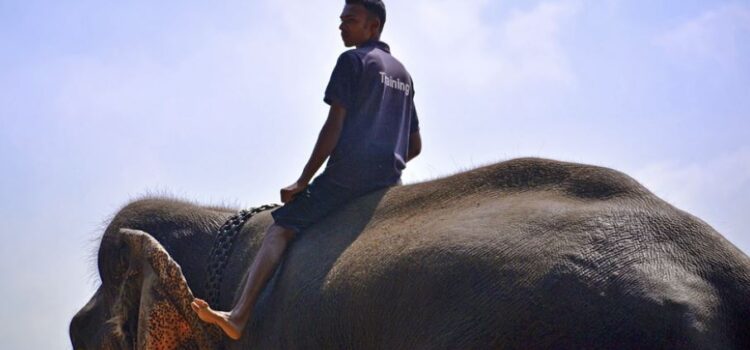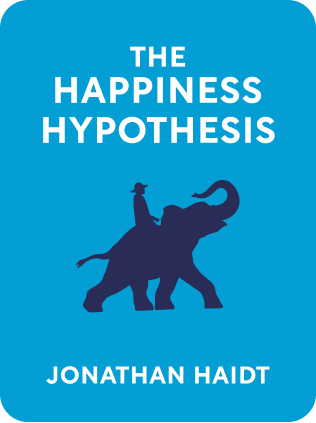

This article is an excerpt from the Shortform book guide to "The Happiness Hypothesis" by Jonathan Haidt. Shortform has the world's best summaries and analyses of books you should be reading.
Like this article? Sign up for a free trial here .
How does the metaphor of the elephant and the rider signify a divided mind? In what four ways is the mind divided? What are primal emotions?
In the book The Happiness Hypothesis by Jonathan Haidt, he uses the metaphor of a person riding an elephant to explain the human mind. However, the rider/elephant metaphor only describes the back-and-forth struggle going on within the self. There are other dimensions to this division.
Keep reading to learn more about the elephant and the rider and the four divisions of the mind.
The Elephant and the Rider
The aptest metaphor for thinking about the human mind is the elephant and the rider, as introduced in The Happiness Hypothesis. The rider, representing reason, can do her best to attempt to direct the elephant. But the elephant is far more powerful and has its own will; it will only comply with the rider’s commands if those commands are not in conflict with its desire. Thus, the rational part of ourselves can advise and guide our emotional core; but in a pure contest of wills, emotion will nearly always defeat reason.
This rider/elephant metaphor neatly describes the back-and-forth struggle going on within the self. But there are other dimensions to this division. The mind is divided in four key ways:
- Head brain vs. gut brain
- Left and right hemispheres
- Frontal cortex vs. limbic system
- Conscious vs. unconscious
Division 1: Head Brain vs. Gut Brain
We’ve all experienced involuntary bodily reactions before, when our bodies reveal our innermost thoughts even when we don’t want them to. Our palms sweat when we’re nervous and our eyes tear up when we’re sad or angry.
This is because our autonomic nervous system, or “gut brain,” controls many bodily functions separately from the “head brain,” where conscious thought lives. The two simultaneously influence one another, but can also operate independently of one another.
Division 2: Left and Right Hemispheres
Our brains are divided into two hemispheres. The left hemisphere controls language and analytical tasks. The right side, meanwhile, recognizes patterns, and is most notably responsible for facial recognition. The two hemispheres are connected by a mass of nerve fibers called the corpus callosum.
We can see the split in action in patients who have had the corpus callosum severed or damaged in some way. This causes a literal “split-brain” syndrome in which the two hemispheres begin to function independently of one another. Thus, the left hand (which is controlled by the right hemisphere) might pick up objects that the patient has consciously put down with the right hand, and even attempt to physically restrain actions that the patient is consciously attempting to do with the right hand.
Neurologists have discovered that people with more brainwave activity in their left hemispheres tend to have higher levels of overall happiness than do people with more brainwave activity in their right hemispheres. We’ll explore this in greater detail when we discuss negativity bias and affective style in the next chapter.
Division 3: Frontal Cortex vs. Limbic System
As human survival came to depend on the successful execution of complex tasks and thinking, natural selection began to favor the development of more advanced parts of the brain.
This is why we have a frontal cortex, which is one of the “newer” parts of the brain (from an evolutionary perspective). In our rider/elephant metaphor, we can think of the frontal cortex as the rider. It enables higher thinking, analysis, and decision making. It is what gives us the power to learn and analogize from previous experiences, rather than only responding to particular situations.
This power of generalization is vitally important for human survival. You couldn’t function in society, for example, if you had no ability to recognize the general form of a human face and instead had to examine the face of every person you encountered before you determined it was another person. Generalization enables us to aggregate inputs and distill them down to general patterns that inform our reactions to stimuli.
Our limbic system, meanwhile, coordinates our drives and desires. In our metaphor, we can think of it as the elephant, wrestling for control with the frontal cortex. And, like the elephant, it exerts a great deal of control. Indeed, it can be dominant.
But we should be careful not to overgeneralize. Reason and emotion are not mutually exclusive or engaged in some zero-sum contest against one another. While emotion is usually the senior partner in the relationship, it is a partnership nonetheless. The two work together—reason enhances our emotional intelligence and our emotional intelligence strengthens our powers of reason.
One of the most effective ways to enhance our happiness is to bring reason and emotion into better harmony, by using the power of reason to guide (but not control) our emotions toward healthier and more fulfilling desires.
Division 4: Conscious vs. Unconscious
Most mental processes are unconscious, although they are capable of influencing behavior that we think is conscious. Experiments have shown, for example, how seeing words related to older people causes test subjects to walk more slowly. We might have hundreds of such unconscious processes going on at once.
Conscious processing, on the other hand, usually involves more complex strategies and planning. We can only consciously think about one thing at a time. The conscious processing parts of our brain, like language, are relatively “young” and we still haven’t quite worked out how to use them.
The conscious processing parts of our brains let us exert some control over our immediate desires for pleasures like food and sex, but the automatic system still has the upper hand. We are not complete masters over our desires, and we may never be.
The Primacy of Emotion
As humans, we are controlled primarily by our desires, which are driven by our emotions—not our powers of reason. This is the most consequential manifestation of the split-brain phenomenon. One part of our brain, the elephant, determines our opinions and positions on moral questions; the other part of our brain, the rider, creates reasons to justify those opinions—but only after the elephant has made its decision.
The automatic system (the elephant) simply responds to stimuli around it and forms judgments and preferences based on what it perceives. And, in a pure contest of wills, the automatic system (the elephant) will nearly always beat the controlled system (the rider). The key is to change the stimuli in your environment into those that will produce desires whose pursuit and fulfillment will lead to true satisfaction. You can’t master the elephant; but, perhaps, you can change what the elephant sees.
Of course, this is easier said than done. If someone tells you, “Don’t think of a hippopotamus,” it is nearly impossible to consciously not think of one. Similarly, we often find ourselves thinking about doing or saying outlandish things at inappropriate times. The reason is that we obviously know we’re not supposed to do those things. But the fact that the avoidance of such behavior is a social goal forces our minds to evaluate our progress toward that goal—and, in the course of that evaluation, we think about the behavior we know we’re supposed to avoid.
We would be healthier and happier if we paid less attention to the controlled, conscious parts of ourselves and accepted the elephant as an equally vital (if not more vital) part of ourselves. Too often, we treat it as some alien, external entity that we must struggle to master. But this is not the case. Instead, we need to reconcile and harmonize the two components of the self.
The remaining chapters of this summary will use the split-brain phenomenon as the basis for understanding how and why we experience happiness—and how we can use this understanding to maximize our happiness.

———End of Preview———
Like what you just read? Read the rest of the world's best book summary and analysis of Jonathan Haidt's "The Happiness Hypothesis" at Shortform .
Here's what you'll find in our full The Happiness Hypothesis summary :
- How your emotions determine how satisfied you are in life
- Why you need to struggle in order to succeed
- How to create your own happiness






